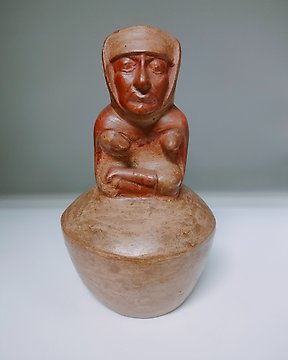
Pre-Columbian Moche Keramisk flaska med shaman - med spansk exportlicens huaco
Nr 82533543

Nr 82533543

Description
India, Orissa, 11th-12th century.
Standing in kayotsarga on a lotus blossom with hair curling at his shoulders, flanked by Gomukha and Chakreshvari, surrounded by smaller seated deities below flying apsaras, the lower register with kneeling worshippers centered by a bull, his head backed by a circular halo with beaded and foliate decoration.
Video link
https://www.dropbox.com/scl/fo/d0a8b3r7zsj08qwln9s8y/h?rlkey=2hcy6mef1zq8uip7tnk9c4iyr&dl=0
Provenance:
From the private collection of Camille Mines (1950-2018), Luxembourg. By repute acquired by his father, Rene Mines, in the local trade during the early 1970s. By descent to Robert Mines.
Condition:
Good condition, commensurate with age. Extensive wear, losses, nicks, scratches, signs of weathering and erosion, structural cracks, some possibly with minor old fills, and encrustations.
Weight: 23.8 kg - 29 kg including the stand
Dimensions including the stand :
33 x 14 x 54 cm
Note
Jainism is propagated through the stories of twenty-four Tirthankaras, figures who have conquered samsara (the cycle of death and rebirth) and provide others a path to follow them to moksha (liberation). Tirthankaras are often depicted as an ideal yogi in a seated posture, as in the present example, or kayotsarga, the standing 'body-abandonment' pose.
Rishabhanatha, also known as Adinatha, is the first of the 24 Tirthankaras, identified by his symbol, the bull, and his distinctive hairstyle. When King Rishabhanatha renounced the world, he began to uproot his hair in the presence of Indra. After removing five handfuls, Indra asked him to stop when he saw how beautifully his remaining hair graced his shoulders. According to Digambara sources, he shaved all his hair, and it grew back in long locks during meditation.
Literature comparison:
Compare a closely related stele of Rishabhanatha, also attributed to Orissa and dated 11th-12th century, in the Musee Guimet, Paris.
Auction result comparison:
Type: Related
Auction: C h r i s t i e ' s New York, 21 March 2012, lot 746
Price: USD 35,000 or approx. EUR 41,000 converted and adjusted for inflation at the time of writing
Description: A black stone stele of Rishabhanatha, India, Karnataka, 12th century
Expert remark: Note the smaller size (43.2 cm)
#ExclusiveCabinetofCuriosities
Hur du köper på Catawiki
1. Upptäck något speciellt
2. Lägg det högsta budet
3. Gör en säker betalning